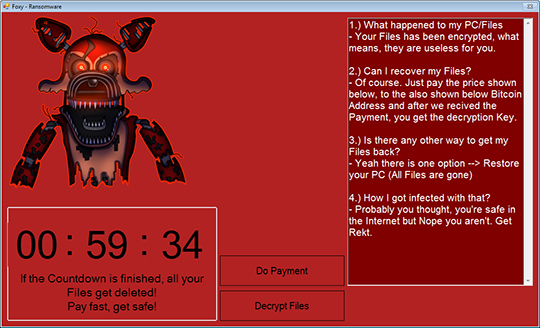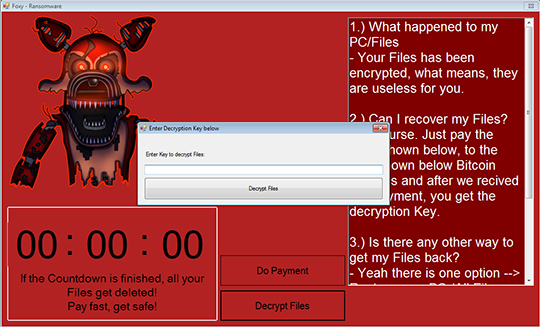RANSOM_FOXY.A
Troj/Cryptear-A (SOPHOS_LITE),Ransom:MSIL/Ryzerlo.A [non_writable_container] (MICROSOFT)
Windows


Threat Type: Ransomware
Destructiveness: No
Encrypted: No
In the wild: Yes
OVERVIEW
Dropped by other malware, Downloaded from the Internet
This Ransomware arrives on a system as a file dropped by other malware or as a file downloaded unknowingly by users when visiting malicious sites.
It is capable of encrypting files in the affected system.
It encrypts files found in specific folders. It drops files as ransom note.
TECHNICAL DETAILS
237,056 bytes
, EXE
No
07 Nov 2017
Displays windows, Displays message/message boxes, Encrypts files
Arrival Details
This Ransomware arrives on a system as a file dropped by other malware or as a file downloaded unknowingly by users when visiting malicious sites.
Installation
This Ransomware drops and executes the following files:
- %User Temp%\WindowsSoundDriver.exe
(Note: %User Temp% is the user's temporary folder, where it usually is C:\Documents and Settings\{user name}\Local Settings\Temp on Windows 2000, Windows Server 2003, and Windows XP (32- and 64-bit); C:\Users\{user name}\AppData\Local\Temp on Windows Vista (32- and 64-bit), Windows 7 (32- and 64-bit), Windows 8 (32- and 64-bit), Windows 8.1 (32- and 64-bit), Windows Server 2008, and Windows Server 2012.)
Other Details
This Ransomware encrypts files with the following extensions:
- .txt
- .doc
- .docx
- .xls
- .xlsx
- .ppt
- .pptx
- .odt
- .jpg
- .png
- .csv
- .sql
- .mdb
- .sln
- .php
- .asp
- .aspx
- .html
- .xml
- .psd
- .mp3
- .dll
- .cat
- .inf
- .exe
- .dat
- .wav
- .wma
- .m4a
- .avi
- .avi
- .mov
- .wmv
- .flv
- .gif
- .mpg
- .mp4
- .jar
- .java
- .sav
- .ico
- .torrent
It drops the following file(s)/component(s):
- %User Profile%\Documents\decrpt.openwithnotepad - contains the 15 random-generated characters decryption key
- %AppDataLocal%\GDIPFONTCACHEV1.DAT - font cache
(Note: %User Profile% is the current user's profile folder, which is usually C:\Documents and Settings\{user name} on Windows 2000, XP, and Server 2003, or C:\Users\{user name} on Windows Vista and 7.. %AppDataLocal% is the Application Data folder found in Local Settings, where it is usually C:\Documents and Settings\{user name}\Local Settings\Application Data on Windows 2000, Windows Server 2003, and Windows XP (32- and 64-bit); C:\Users\{user name}\AppData\Local on Windows Vista (32- and 64-bit), Windows 7 (32- and 64-bit), Windows 8 (32- and 64-bit), Windows 8.1 (32- and 64-bit), Windows Server 2008, and Windows Server 2012.)
It is capable of encrypting files in the affected system.
Ransomware Routine
This Ransomware encrypts files found in the following folders:
- %Application Data%\
- %Program Files%\
- %Desktop%\
- My Music Folder
- My Computer Folder
- Personal folder - The directory that serves as a common repository for documents.
(Note: %Application Data% is the Application Data folder, where it usually is C:\Documents and Settings\{user name}\Application Data on Windows 2000, Windows Server 2003, and Windows XP (32- and 64-bit); C:\Users\{user name}\AppData\Roaming on Windows Vista (32- and 64-bit), Windows 7 (32- and 64-bit), Windows 8 (32- and 64-bit), Windows 8.1 (32- and 64-bit), Windows Server 2008, and Windows Server 2012.. %Program Files% is the Program Files folder, where it usually is C:\Program Files on all Windows operating system versions; C:\Program Files (x86) for 32-bit applications running on Windows 64-bit operating systems.. %Desktop% is the desktop folder, where it usually is C:\Documents and Settings\{user name}\Desktop in Windows 2000, Windows Server 2003, and Windows XP (32- and 64-bit); C:\Users\{user name}\Desktop in Windows Vista (32- and 64-bit), Windows 7 (32- and 64-bit), Windows 8 (32- and 64-bit), Windows 8.1 (32- and 64-bit), Windows Server 2008, and Windows Server 2012.)
It appends the following extension to the file name of the encrypted files:
- nightmare
It drops the following file(s) as ransom note:
- %Desktop%\READ_ME_IMPORTANT.txt

NOTES:
This ransomware displays the following as its ransom note:
The decryption key can be found in %User Profile%\Documents\decrpt.openwithnotepad.
Open it on Notepad and copy-paste the key to the window provided in order to decrypt your files.
It also displays the window below:
The window will close when the decryption process is finished.
SOLUTION
9.850
13.768.03
08 Nov 2017
13.769.00
09 Nov 2017
Step 1
Before doing any scans, Windows XP, Windows Vista, and Windows 7 users must disable System Restore to allow full scanning of their computers.
Step 2
Note that not all files, folders, and registry keys and entries are installed on your computer during this malware's/spyware's/grayware's execution. This may be due to incomplete installation or other operating system conditions. If you do not find the same files/folders/registry information, please proceed to the next step.
Step 3
Search and delete this file
- %AppDataLocal%\GDIPFONTCACHEV1.DAT
- %User Temp%\WindowsSoundDriver.exe
- %User Profile%\Documents\decrpt.openwithnotepad
- %Desktop%\READ_ME_IMPORTANT.txt
Step 4
Scan your computer with your Trend Micro product to delete files detected as RANSOM_FOXY.A. If the detected files have already been cleaned, deleted, or quarantined by your Trend Micro product, no further step is required. You may opt to simply delete the quarantined files. Please check the following Trend Micro Support pages for more information:
Did this description help? Tell us how we did.

